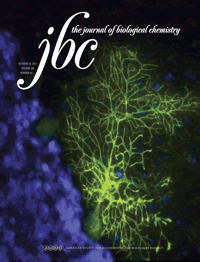
来自厦门大学生命科学学院的研究人员发表了题为“Phosphorylation of Raptor by p38{beta} Participates in Arsenite-induced Mammalian Target of Rapamycin Complex 1 (mTORC1) Activation”的文章,获得了在之前研究成果基础上更深入的发现,即雷帕霉素靶蛋白mTOR活性调控中的又一新机制。这一研究成果公布在JBC杂志上。
领导这一研究的是厦门大学生命科学学院的韩家淮教授,他长期从事应激反应的信号转导研究,在世界上率先发现p38应激信号通路。近年来韩家淮教授在细胞应激坏死机制研究方向上取得一系列突破性进展,研究成果屡次发表在Cell、Nature和Science三大世界顶尖杂志及姊妹杂志上。
细胞生长受到环境的影响,哺乳动物雷帕霉素靶蛋白(mammalian target of rapamycin, mTOR) 是一种存在于哺乳动物细胞中的Ser/Thr激酶。近年来大量研究表明mTOR与人体炎症、损伤、增生、组织修复、纤维化以及肿瘤发生发展等一系列重要的病理生理过程密切相关。深入的研究也证实mTOR可通过汇聚和整合来自于营养、生长因子、能量和环境胁迫对细胞的刺激信号,进而调节细胞生长。
与mTOR这一作用密切联系的是一种称为丝裂原活化蛋白激酶p38(p38MAP激酶),在之前的研究中,韩家淮课题组研究人员发现p38β丝裂原活化蛋白激酶MAPK以及p38调节/激活蛋白激酶(PRAK)级联反应与细胞低能量水平状态下的mTOR活性抑制有关。
在最新这篇文章中,研究人员进一步发现p38β激活mTOR复合物1(mTORC1)活性的过程与砷密切相关,而不是以往认为的胰岛素,营养素,茴香毒素(anisomycin),或者过氧化氢。研究人员通过对细胞施用砷,能激活p38β,并诱导p38β与Raptor之间发生相互作用——后者是mTORC1的一个调控元素,这将引发Raptor的磷酸化,进一步增强mTORC1的活性。
这项研究和之前的研究结果表明p38途径能调控mTORC1途径中的不同组成成分,而且p38β还能在不同的细胞胁迫环境中,通过靶向不同的元件,正调控,或负调控mTORC1的活性,这有助于加深科学家们对于应激环境下mTOR介导的细胞机制的了解。
相关英文论文摘要:
Phosphorylation of Raptor by p38β Participates in Arsenite-induced Mammalian Target of Rapamycin Complex 1 (mTORC1) Activation
Cell growth is influenced by environmental stress. Mammalian target of rapamycin (mTOR), the central regulator of cell growth, can be positively or negatively regulated by various stresses through different mechanisms. The p38 MAP kinase pathway is essential in cellular stress responses. Activation of MK2, a downstream kinase of p38α, enhances mTOR complex 1 (mTORC1) activity by preventing TSC2 from inhibiting mTOR activation. The p38β-PRAK cascade targets Rheb to inhibit mTORC1 activity upon glucose depletion. Here we show the activation of p38β participates in activation of mTOR complex 1 (mTORC1) induced by arsenite but not insulin, nutrients, anisomycin, or H2O2. Arsenite treatment of cells activates p38β and induces interaction between p38β and Raptor, a regulatory component of mTORC1, resulting in phosphorylation of Raptor on Ser863 and Ser771. The phosphorylation of Raptor on these sites enhances mTORC1 activity, and contributes largely to arsenite-induced mTORC1 activation. Our results shown here and in previous work demonstrate that the p38 pathway can regulate different components of the mTORC1 pathway, and that p38β can target different substrates to either positively or negatively regulate mTORC1 activation when a cell encounters different environmental stresses.







